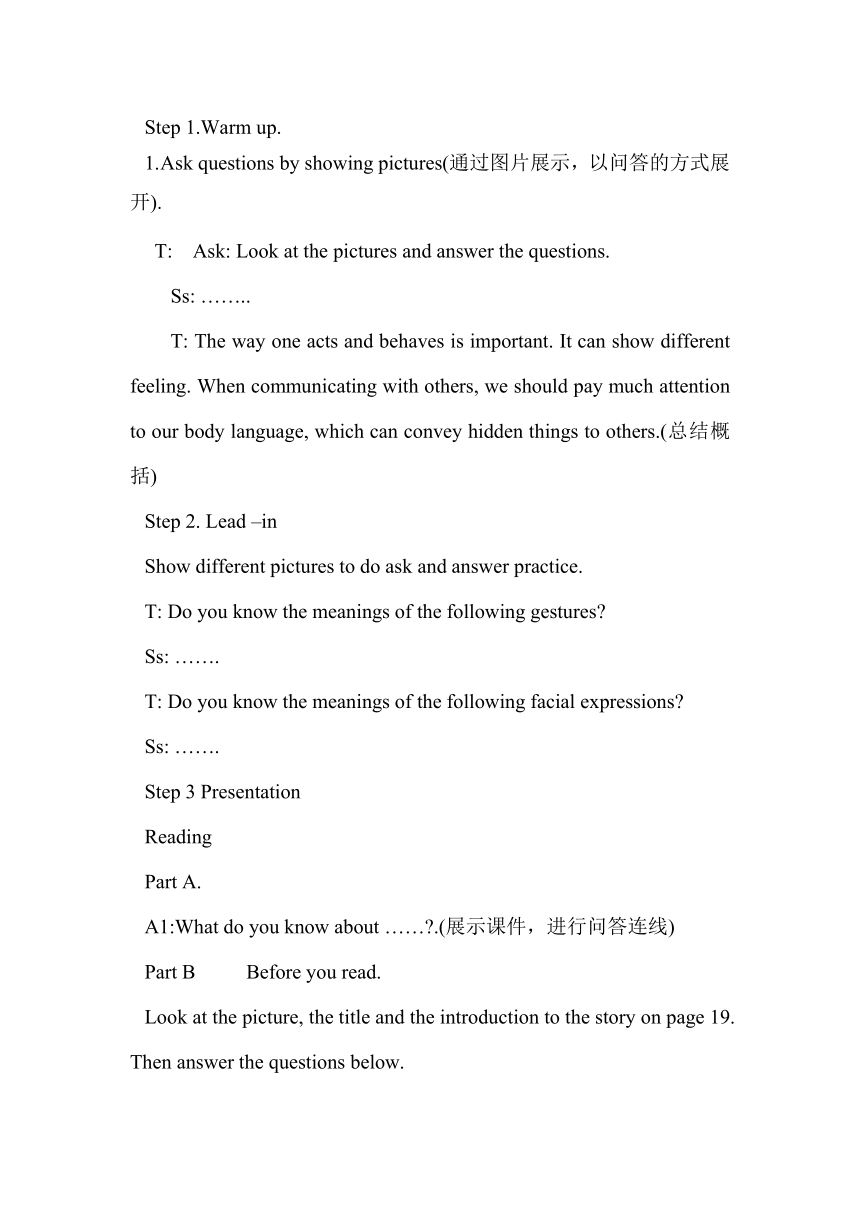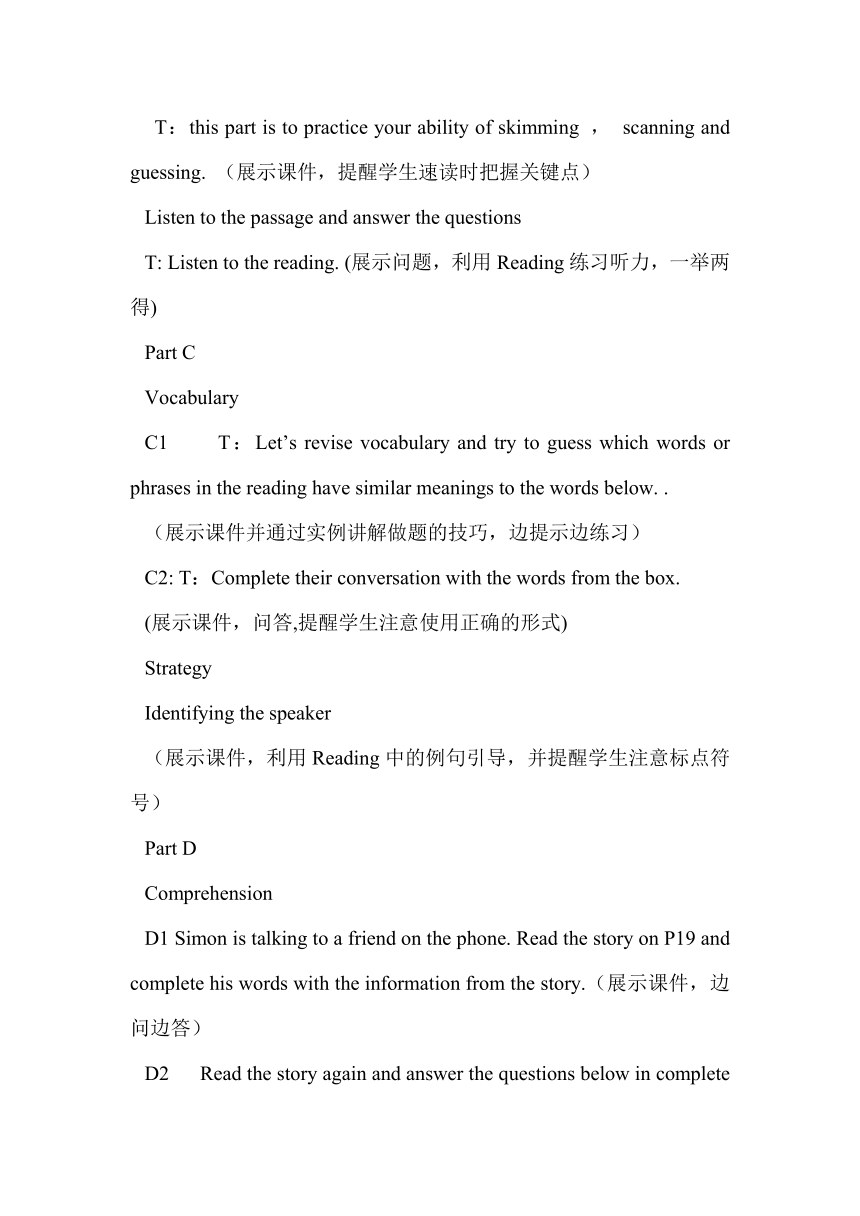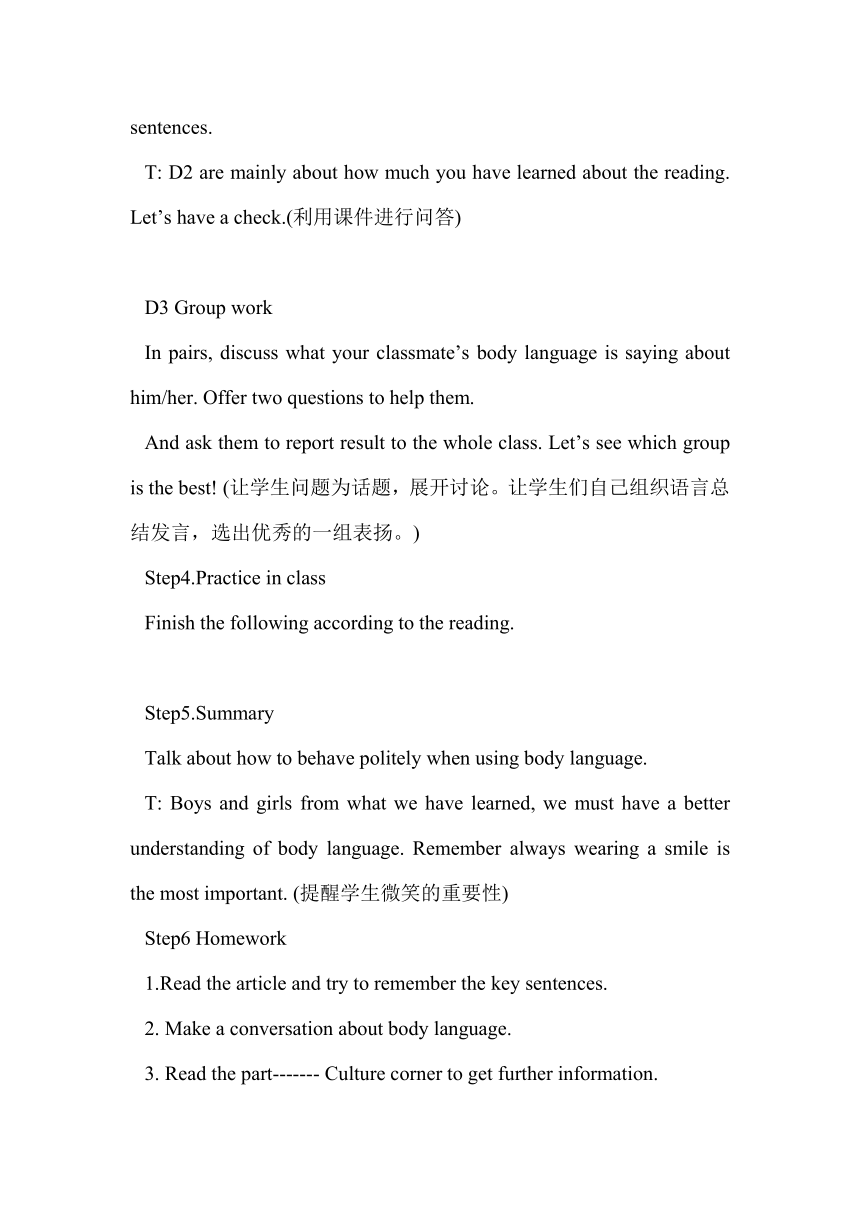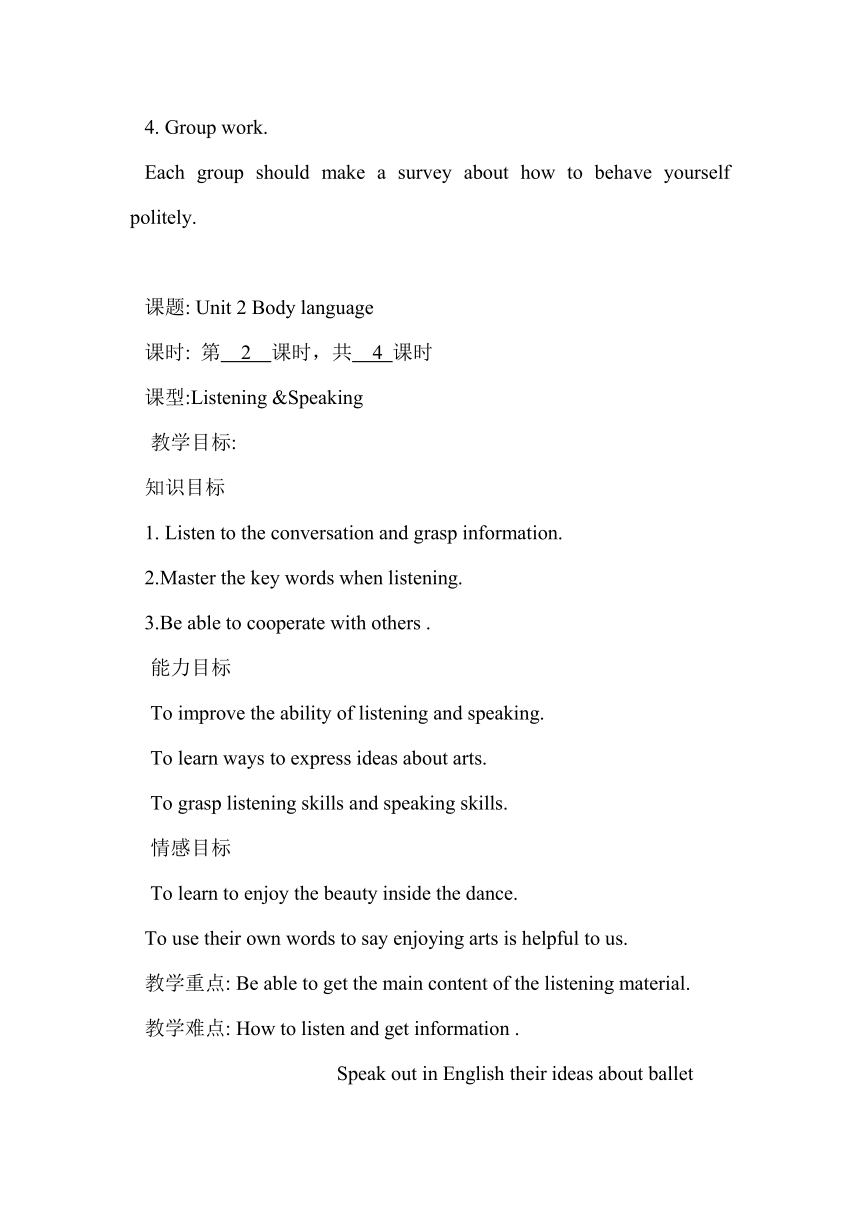广东省深圳市Module 1 Unit 2 Body language 教案(4课时)
文档属性
| 名称 | 广东省深圳市Module 1 Unit 2 Body language 教案(4课时) |  | |
| 格式 | zip | ||
| 文件大小 | 124.0KB | ||
| 资源类型 | 教案 | ||
| 版本资源 | 牛津深圳版 | ||
| 科目 | 英语 | ||
| 更新时间 | 2017-07-26 00:00:00 | ||
图片预览





文档简介
Module
1
Unit
2
Body
language
教案
课题:
Unit
2
Body
language
课时:
第
1
课时,共
4
课时
课型:Reading
教学目标:
知识目标
1.
Students
can
use
skimming
and
scanning
to
get
the
main
idea
of
the
reading
and
some
details
.
2.
Students
can
grasp
key
words
and
sentences.
3.
Students
get
to
know
how
to
use
words
to
form
sentences.
能力目标
To
improve
the
ability
of
reading.
To
do
the
practice
themselves.
To
learn
the
usage
of
words
and
phrases.
情感目标
To
learn
how
to
use
body
language
correctly
and
behave
politely
.
To
learn
the
importance
of
body
language
and
the
differences
between
various
cultures.
教学重点:
Get
the
main
idea
of
the
reading.
教学难点:
Key
words
and
sentences
教学步骤:
Step
1.Warm
up.
Ask
questions
by
showing
pictures(通过图片展示,以问答的方式展开).
T:
Ask:
Look
at
the
pictures
and
answer
the
questions.
Ss:
……..
T:
The
way
one
acts
and
behaves
is
important.
It
can
show
different
feeling.
When
communicating
with
others,
we
should
pay
much
attention
to
our
body
language,
which
can
convey
hidden
things
to
others.(总结概括)
Step
2.
Lead
–in
Show
different
pictures
to
do
ask
and
answer
practice.
T:
Do
you
know
the
meanings
of
the
following
gestures
Ss:
…….
T:
Do
you
know
the
meanings
of
the
following
facial
expressions
Ss:
…….
Step
3
Presentation
Reading
Part
A.
A1:What
do
you
know
about
…… .(展示课件,进行问答连线)
Part
B
Before
you
read.
Look
at
the
picture,
the
title
and
the
introduction
to
the
story
on
page
19.
Then
answer
the
questions
below.
T:this
part
is
to
practice
your
ability
of
skimming
,
scanning
and
guessing.
(展示课件,提醒学生速读时把握关键点)
Listen
to
the
passage
and
answer
the
questions
T:
Listen
to
the
reading.
(展示问题,利用Reading练习听力,一举两得)
Part
C
Vocabulary
C1
T:Let’s
revise
vocabulary
and
try
to
guess
which
words
or
phrases
in
the
reading
have
similar
meanings
to
the
words
below.
.
(展示课件并通过实例讲解做题的技巧,边提示边练习)
C2:
T:Complete
their
conversation
with
the
words
from
the
box.
(展示课件,问答,提醒学生注意使用正确的形式)
Strategy
Identifying
the
speaker
(展示课件,利用Reading中的例句引导,并提醒学生注意标点符号)
Part
D
Comprehension
D1
Simon
is
talking
to
a
friend
on
the
phone.
Read
the
story
on
P19
and
complete
his
words
with
the
information
from
the
story.(展示课件,边问边答)
D2
Read
the
story
again
and
answer
the
questions
below
in
complete
sentences.
T:
D2
are
mainly
about
how
much
you
have
learned
about
the
reading.
Let’s
have
a
check.(利用课件进行问答)
D3
Group
work
In
pairs,
discuss
what
your
classmate’s
body
language
is
saying
about
him/her.
Offer
two
questions
to
help
them.
And
ask
them
to
report
result
to
the
whole
class.
Let’s
see
which
group
is
the
best!
(让学生问题为话题,展开讨论。让学生们自己组织语言总结发言,选出优秀的一组表扬。)
Step4.Practice
in
class
Finish
the
following
according
to
the
reading.
Step5.Summary
Talk
about
how
to
behave
politely
when
using
body
language.
T:
Boys
and
girls
from
what
we
have
learned,
we
must
have
a
better
understanding
of
body
language.
Remember
always
wearing
a
smile
is
the
most
important.
(提醒学生微笑的重要性)
Step6
Homework
1.Read
the
article
and
try
to
remember
the
key
sentences.
2.
Make
a
conversation
about
body
language.
3.
Read
the
part-------
Culture
corner
to
get
further
information.
4.
Group
work.
Each
group
should
make
a
survey
about
how
to
behave
yourself
politely.
课题:
Unit
2
Body
language
课时:
第
2
课时,共
4
课时
课型:Listening
&Speaking
教学目标:
知识目标
1.
Listen
to
the
conversation
and
grasp
information.
2.Master
the
key
words
when
listening.
3.Be
able
to
cooperate
with
others
.
能力目标
To
improve
the
ability
of
listening
and
speaking.
To
learn
ways
to
express
ideas
about
arts.
To
grasp
listening
skills
and
speaking
skills.
情感目标
To
learn
to
enjoy
the
beauty
inside
the
dance.
To
use
their
own
words
to
say
enjoying
arts
is
helpful
to
us.
教学重点:
Be
able
to
get
the
main
content
of
the
listening
material.
教学难点:
How
to
listen
and
get
information
.
Speak
out
in
English
their
ideas
about
ballet
教学步骤:
Step1.Lead-in
Use
picture
to
lead
in
.
T:
The
picture
shows
a
beautiful
dance
called
ballet,
in
which
dancers
use
their
body
language
to
express
feeling.
(引导学生对ballet进行了解)
Step
2.
Presentation.
1.Listening
Listen
to
a
speech
about
ballet
and
complete
the
notes
below.
Write
one
word
in
each
blank.
(1).
Play
the
recording
and
lead
students
to
finish
the
listening
exercises
by
taking
down
the
key
words.
(2).Present
some
expressions
and
sentences.
(要求学生跟读听力材料,模仿语音语调。)
Group
work
Work
in
pair
to
ask
and
answer.
Do
you
like
watching
ballet
Why
or
Why
not?
Speaking
A
Talk
time
Learn
to
make
,
accepting
and
rejecting
suggestions
(2).Help
the
Ss
when
necessary.
(3)Use
the
following:
Let’s
(do)
…!
/
Shall
we
(do)
…
Why
don’t
we/you
(do)
…
Why
not
(do)…
What/How
about
(doing)
…
You’d
better
(do)
…
!…..
(根据前面积累的一些口语表达,听说结合练习)
B
Speak
up
Match
the
phrases
from
the
box
with
the
correct
pictures.
Encourage
students
to
express
themselves.
(运用图片,指导学生进行口语表达)
Step
3.
Practice
Team
work
Read
the
part-------Culture
corner
to
discuss
different
ways
of
greeting
people.
(拓展知识面)
Step
4.
Homework
Practice
the
listening
again
.
Make
a
dialogue
about
making
suggestions.
Team
work.
Each
team
should
prepare
a
short
play
about
how
body
language
affects
our
lives.
4.
Learn
to
use
body
language
correctly.
课题:
Unit2
Body
language
课时:
第
3
课时,共
4
课时
课型:
Grammar
教学目标:
知识目标
1.Master
the
usage
of
Gerund
used
as
Subject
and
Object.
2.Use
the
Gerund
freely.
能力目标
To
improve
the
ability
of
using
the
grammar
to
make
sentences.
To
grasp
the
grammar.
情感目标
To
use
Gerund
to
make
sentences.
教学重点:
Work
out
the
rules
of
Gerund.
教学难点:
The
rules
of
Gerund
as
Subject
and
Object
教学步骤:
Step1:
Lead-in
Show
a
picture
and
talk
about
the
structure
of
a
sentence.
T:
Communicating
and
speaking
here
are
gerunds.
Brainstorm
What
elements
can
Gerund
be
used
as
Step2:
Presentation
1.
Explain
the
form
and
usage
of
Gerund
.
2.
Work
out
the
rules.
3.
Explain
how
Gerund
is
used
as
Subject
and
Object.
(展示课件,边讲边练,提醒需要注意的地方)
Step3:
Practice
Do
practice
in
class.
Step4:
Homework
1.Grasp
the
usage
of
Gerunds.
2.
Grasp
Gerunds
used
as
Subject
and
Object
.
3.
Do
the
Gerund
practice
in
book
again.
4.
Revise
the
whole
unit.
课题:
Unit
2
Body
language
课时:
第
4
课时,共
4
课时
课型:
Writing
教学目标:
知识目标
To
grasp
how
to
write
a
short
message.
Master
the
skills
of
writing.
能力目标
To
develop
the
ability
of
writing.
To
improve
writing
skills.
情感目标
Have
a
better
understanding
of
the
importance
of
using
words
to
write
a
message.
教学重点:
The
skills
of
writing.
教学难点:Writing
details
教学步骤:
Step1:Revision
Read
the
passage------
Eye
contact
on
Page
29
and
answer
the
questions.
(展示课件,进行ask
&answer)
Step
2
Lead
in
T:
Look
at
the
short
passage
and
guess
what
a
passage
probably
includes.
Ss:……
Summary:
a
greeting
(eg.
Dear….)
the
topic
expression
the
end
(eg.
Best
wishes)
Step3:
Presentation
Explain
what
a
message
includes.(展示课件,边演示边讲解)
(1)
What
does
a
short
message
include
Look
at
the
short
message
below
and
write
the
letters
a
–f
in
the
blanks.
(Ask
and
answer.
展示课件讲解the
form
of
a
message及其写作要点)
(2)Team
work
Discuss
how
different
a
message
is
from
a
letter
in
form.
Examples
Practice
a
message
and
give
an
example
to
emphasize
details.
(先让学生写,最后总结并提示学生注意点)
Step4.
Practice
Complete
a
short
message
Practice
a
message
writing.
Step
5
Summary
Useful
expressions
to
write
a
passage
Step
6:
Homework
1.Revise
the
whole
unit.
2.Finish
off
the
Exx
in
Wb.
3.
Write
a
short
message
to
your
classmate
according
to
the
given
situation
below.
请在前一天写一张便条提醒你的同学John,于3月12日上午9点,在人民公园参加植树活动(tree-planting
activity),提醒他记得带好铲(shovel)和水桶(bucket)
1
Unit
2
Body
language
教案
课题:
Unit
2
Body
language
课时:
第
1
课时,共
4
课时
课型:Reading
教学目标:
知识目标
1.
Students
can
use
skimming
and
scanning
to
get
the
main
idea
of
the
reading
and
some
details
.
2.
Students
can
grasp
key
words
and
sentences.
3.
Students
get
to
know
how
to
use
words
to
form
sentences.
能力目标
To
improve
the
ability
of
reading.
To
do
the
practice
themselves.
To
learn
the
usage
of
words
and
phrases.
情感目标
To
learn
how
to
use
body
language
correctly
and
behave
politely
.
To
learn
the
importance
of
body
language
and
the
differences
between
various
cultures.
教学重点:
Get
the
main
idea
of
the
reading.
教学难点:
Key
words
and
sentences
教学步骤:
Step
1.Warm
up.
Ask
questions
by
showing
pictures(通过图片展示,以问答的方式展开).
T:
Ask:
Look
at
the
pictures
and
answer
the
questions.
Ss:
……..
T:
The
way
one
acts
and
behaves
is
important.
It
can
show
different
feeling.
When
communicating
with
others,
we
should
pay
much
attention
to
our
body
language,
which
can
convey
hidden
things
to
others.(总结概括)
Step
2.
Lead
–in
Show
different
pictures
to
do
ask
and
answer
practice.
T:
Do
you
know
the
meanings
of
the
following
gestures
Ss:
…….
T:
Do
you
know
the
meanings
of
the
following
facial
expressions
Ss:
…….
Step
3
Presentation
Reading
Part
A.
A1:What
do
you
know
about
…… .(展示课件,进行问答连线)
Part
B
Before
you
read.
Look
at
the
picture,
the
title
and
the
introduction
to
the
story
on
page
19.
Then
answer
the
questions
below.
T:this
part
is
to
practice
your
ability
of
skimming
,
scanning
and
guessing.
(展示课件,提醒学生速读时把握关键点)
Listen
to
the
passage
and
answer
the
questions
T:
Listen
to
the
reading.
(展示问题,利用Reading练习听力,一举两得)
Part
C
Vocabulary
C1
T:Let’s
revise
vocabulary
and
try
to
guess
which
words
or
phrases
in
the
reading
have
similar
meanings
to
the
words
below.
.
(展示课件并通过实例讲解做题的技巧,边提示边练习)
C2:
T:Complete
their
conversation
with
the
words
from
the
box.
(展示课件,问答,提醒学生注意使用正确的形式)
Strategy
Identifying
the
speaker
(展示课件,利用Reading中的例句引导,并提醒学生注意标点符号)
Part
D
Comprehension
D1
Simon
is
talking
to
a
friend
on
the
phone.
Read
the
story
on
P19
and
complete
his
words
with
the
information
from
the
story.(展示课件,边问边答)
D2
Read
the
story
again
and
answer
the
questions
below
in
complete
sentences.
T:
D2
are
mainly
about
how
much
you
have
learned
about
the
reading.
Let’s
have
a
check.(利用课件进行问答)
D3
Group
work
In
pairs,
discuss
what
your
classmate’s
body
language
is
saying
about
him/her.
Offer
two
questions
to
help
them.
And
ask
them
to
report
result
to
the
whole
class.
Let’s
see
which
group
is
the
best!
(让学生问题为话题,展开讨论。让学生们自己组织语言总结发言,选出优秀的一组表扬。)
Step4.Practice
in
class
Finish
the
following
according
to
the
reading.
Step5.Summary
Talk
about
how
to
behave
politely
when
using
body
language.
T:
Boys
and
girls
from
what
we
have
learned,
we
must
have
a
better
understanding
of
body
language.
Remember
always
wearing
a
smile
is
the
most
important.
(提醒学生微笑的重要性)
Step6
Homework
1.Read
the
article
and
try
to
remember
the
key
sentences.
2.
Make
a
conversation
about
body
language.
3.
Read
the
part-------
Culture
corner
to
get
further
information.
4.
Group
work.
Each
group
should
make
a
survey
about
how
to
behave
yourself
politely.
课题:
Unit
2
Body
language
课时:
第
2
课时,共
4
课时
课型:Listening
&Speaking
教学目标:
知识目标
1.
Listen
to
the
conversation
and
grasp
information.
2.Master
the
key
words
when
listening.
3.Be
able
to
cooperate
with
others
.
能力目标
To
improve
the
ability
of
listening
and
speaking.
To
learn
ways
to
express
ideas
about
arts.
To
grasp
listening
skills
and
speaking
skills.
情感目标
To
learn
to
enjoy
the
beauty
inside
the
dance.
To
use
their
own
words
to
say
enjoying
arts
is
helpful
to
us.
教学重点:
Be
able
to
get
the
main
content
of
the
listening
material.
教学难点:
How
to
listen
and
get
information
.
Speak
out
in
English
their
ideas
about
ballet
教学步骤:
Step1.Lead-in
Use
picture
to
lead
in
.
T:
The
picture
shows
a
beautiful
dance
called
ballet,
in
which
dancers
use
their
body
language
to
express
feeling.
(引导学生对ballet进行了解)
Step
2.
Presentation.
1.Listening
Listen
to
a
speech
about
ballet
and
complete
the
notes
below.
Write
one
word
in
each
blank.
(1).
Play
the
recording
and
lead
students
to
finish
the
listening
exercises
by
taking
down
the
key
words.
(2).Present
some
expressions
and
sentences.
(要求学生跟读听力材料,模仿语音语调。)
Group
work
Work
in
pair
to
ask
and
answer.
Do
you
like
watching
ballet
Why
or
Why
not?
Speaking
A
Talk
time
Learn
to
make
,
accepting
and
rejecting
suggestions
(2).Help
the
Ss
when
necessary.
(3)Use
the
following:
Let’s
(do)
…!
/
Shall
we
(do)
…
Why
don’t
we/you
(do)
…
Why
not
(do)…
What/How
about
(doing)
…
You’d
better
(do)
…
!…..
(根据前面积累的一些口语表达,听说结合练习)
B
Speak
up
Match
the
phrases
from
the
box
with
the
correct
pictures.
Encourage
students
to
express
themselves.
(运用图片,指导学生进行口语表达)
Step
3.
Practice
Team
work
Read
the
part-------Culture
corner
to
discuss
different
ways
of
greeting
people.
(拓展知识面)
Step
4.
Homework
Practice
the
listening
again
.
Make
a
dialogue
about
making
suggestions.
Team
work.
Each
team
should
prepare
a
short
play
about
how
body
language
affects
our
lives.
4.
Learn
to
use
body
language
correctly.
课题:
Unit2
Body
language
课时:
第
3
课时,共
4
课时
课型:
Grammar
教学目标:
知识目标
1.Master
the
usage
of
Gerund
used
as
Subject
and
Object.
2.Use
the
Gerund
freely.
能力目标
To
improve
the
ability
of
using
the
grammar
to
make
sentences.
To
grasp
the
grammar.
情感目标
To
use
Gerund
to
make
sentences.
教学重点:
Work
out
the
rules
of
Gerund.
教学难点:
The
rules
of
Gerund
as
Subject
and
Object
教学步骤:
Step1:
Lead-in
Show
a
picture
and
talk
about
the
structure
of
a
sentence.
T:
Communicating
and
speaking
here
are
gerunds.
Brainstorm
What
elements
can
Gerund
be
used
as
Step2:
Presentation
1.
Explain
the
form
and
usage
of
Gerund
.
2.
Work
out
the
rules.
3.
Explain
how
Gerund
is
used
as
Subject
and
Object.
(展示课件,边讲边练,提醒需要注意的地方)
Step3:
Practice
Do
practice
in
class.
Step4:
Homework
1.Grasp
the
usage
of
Gerunds.
2.
Grasp
Gerunds
used
as
Subject
and
Object
.
3.
Do
the
Gerund
practice
in
book
again.
4.
Revise
the
whole
unit.
课题:
Unit
2
Body
language
课时:
第
4
课时,共
4
课时
课型:
Writing
教学目标:
知识目标
To
grasp
how
to
write
a
short
message.
Master
the
skills
of
writing.
能力目标
To
develop
the
ability
of
writing.
To
improve
writing
skills.
情感目标
Have
a
better
understanding
of
the
importance
of
using
words
to
write
a
message.
教学重点:
The
skills
of
writing.
教学难点:Writing
details
教学步骤:
Step1:Revision
Read
the
passage------
Eye
contact
on
Page
29
and
answer
the
questions.
(展示课件,进行ask
&answer)
Step
2
Lead
in
T:
Look
at
the
short
passage
and
guess
what
a
passage
probably
includes.
Ss:……
Summary:
a
greeting
(eg.
Dear….)
the
topic
expression
the
end
(eg.
Best
wishes)
Step3:
Presentation
Explain
what
a
message
includes.(展示课件,边演示边讲解)
(1)
What
does
a
short
message
include
Look
at
the
short
message
below
and
write
the
letters
a
–f
in
the
blanks.
(Ask
and
answer.
展示课件讲解the
form
of
a
message及其写作要点)
(2)Team
work
Discuss
how
different
a
message
is
from
a
letter
in
form.
Examples
Practice
a
message
and
give
an
example
to
emphasize
details.
(先让学生写,最后总结并提示学生注意点)
Step4.
Practice
Complete
a
short
message
Practice
a
message
writing.
Step
5
Summary
Useful
expressions
to
write
a
passage
Step
6:
Homework
1.Revise
the
whole
unit.
2.Finish
off
the
Exx
in
Wb.
3.
Write
a
short
message
to
your
classmate
according
to
the
given
situation
below.
请在前一天写一张便条提醒你的同学John,于3月12日上午9点,在人民公园参加植树活动(tree-planting
activity),提醒他记得带好铲(shovel)和水桶(bucket)
同课章节目录
